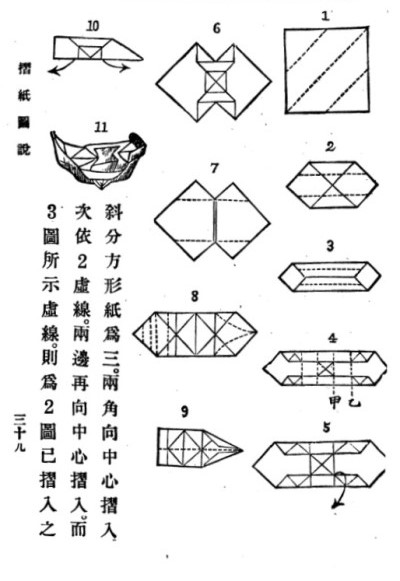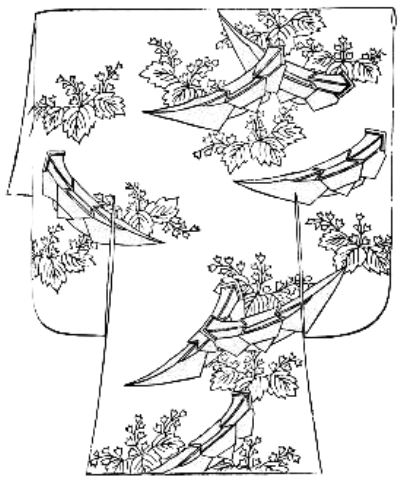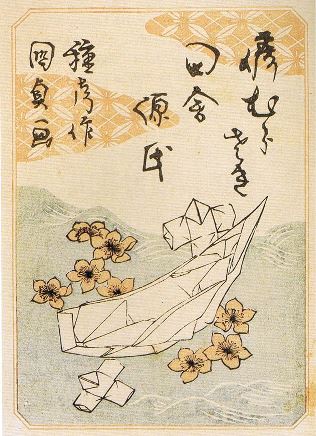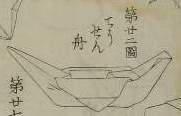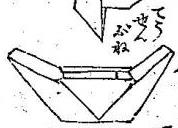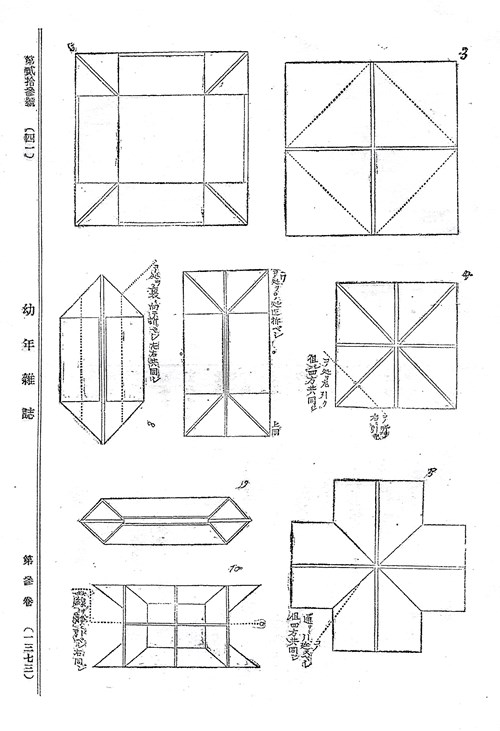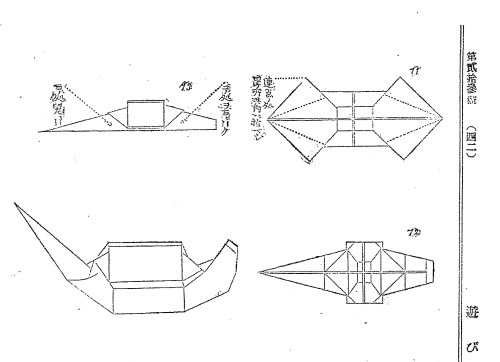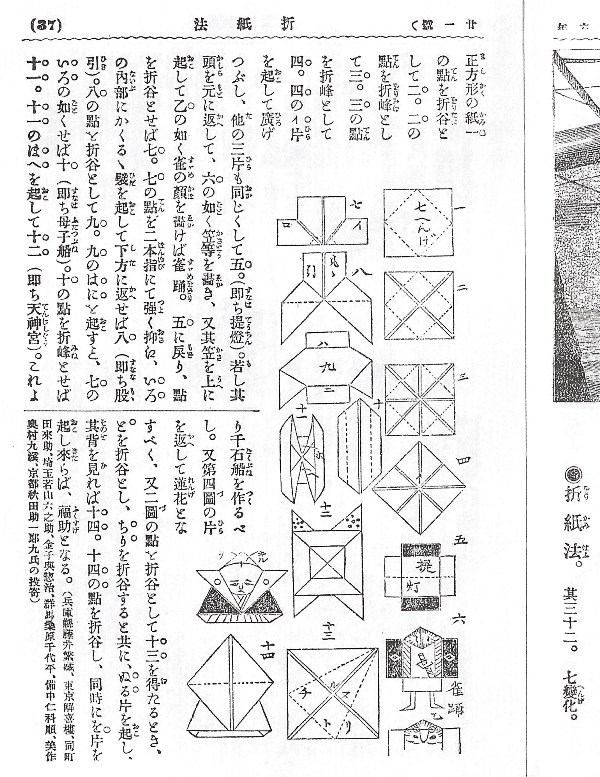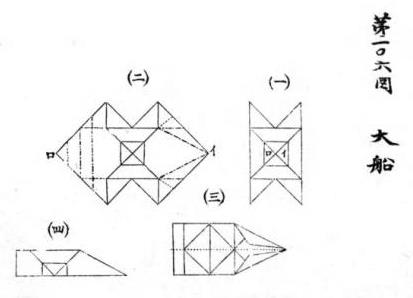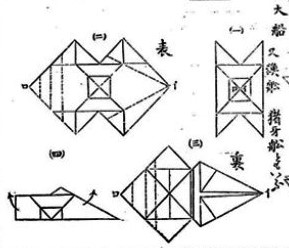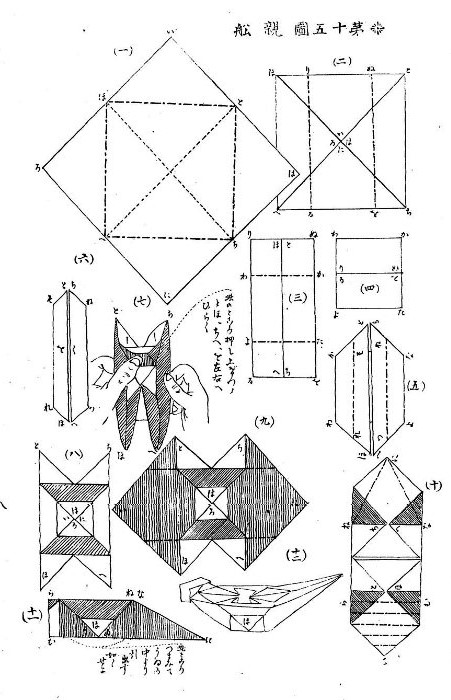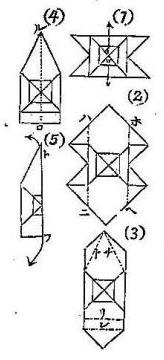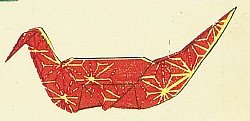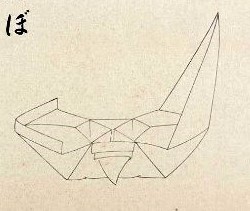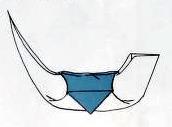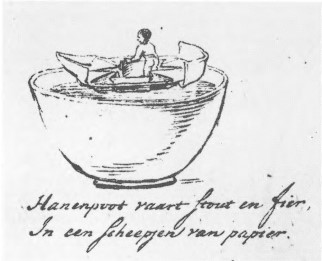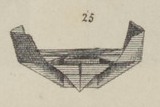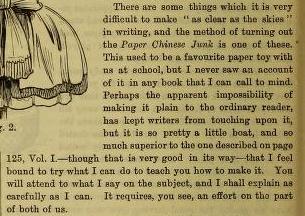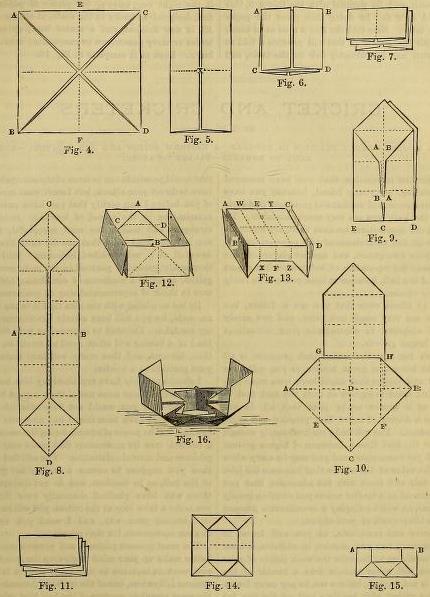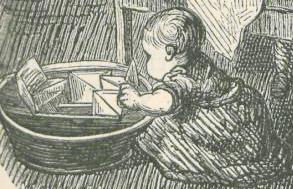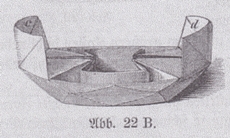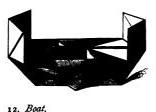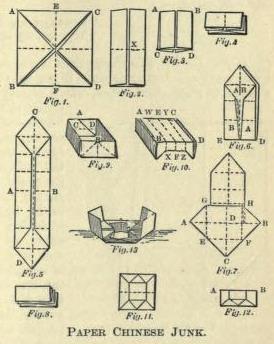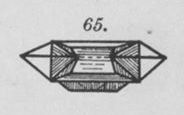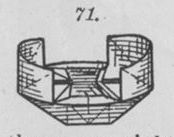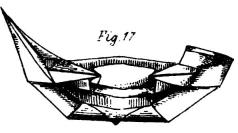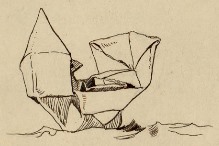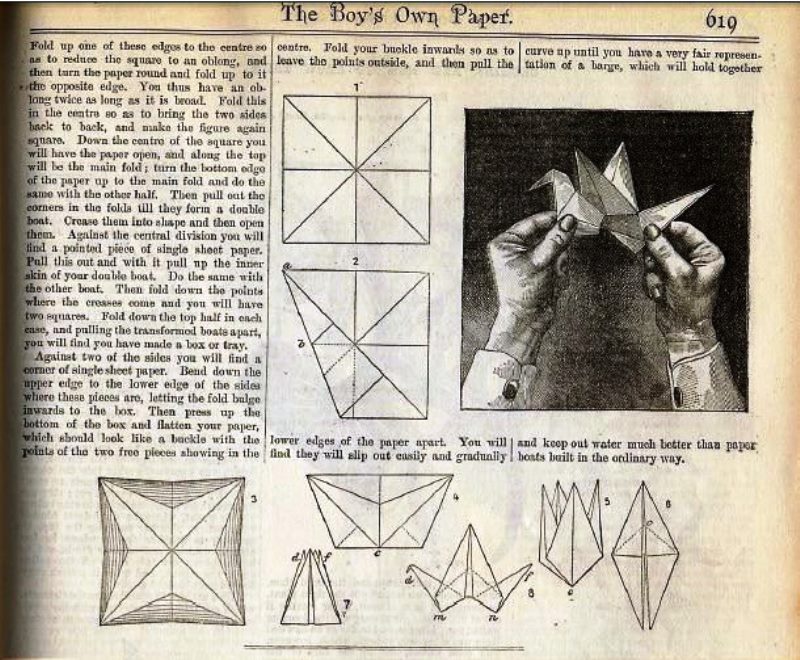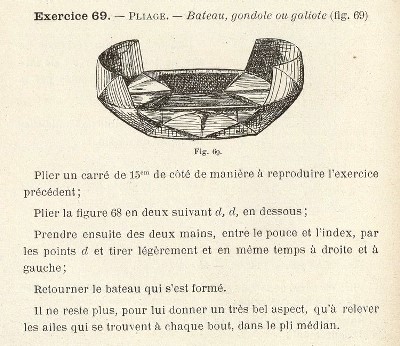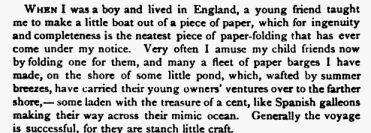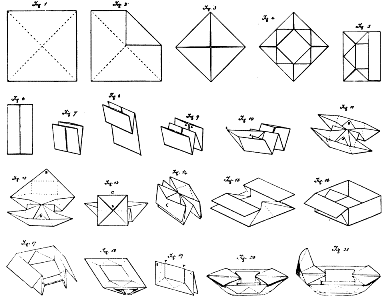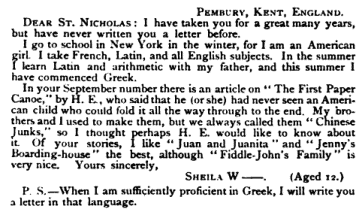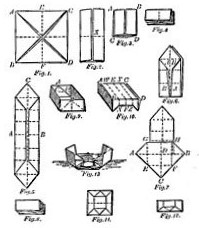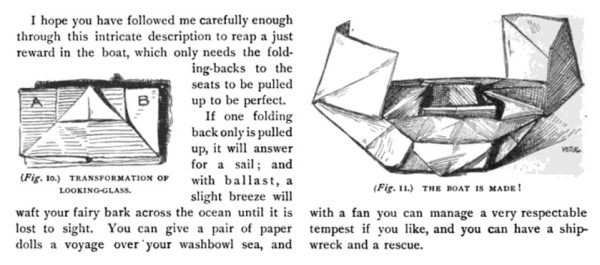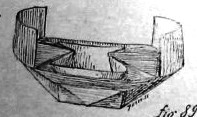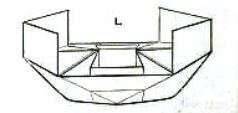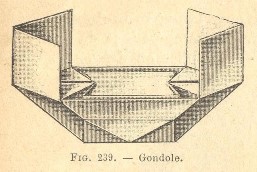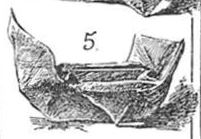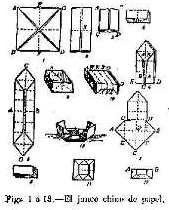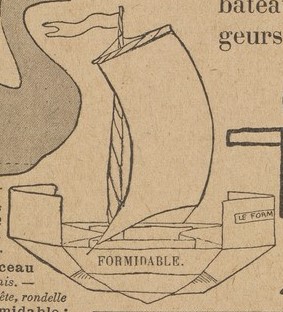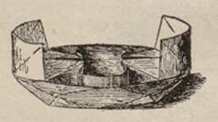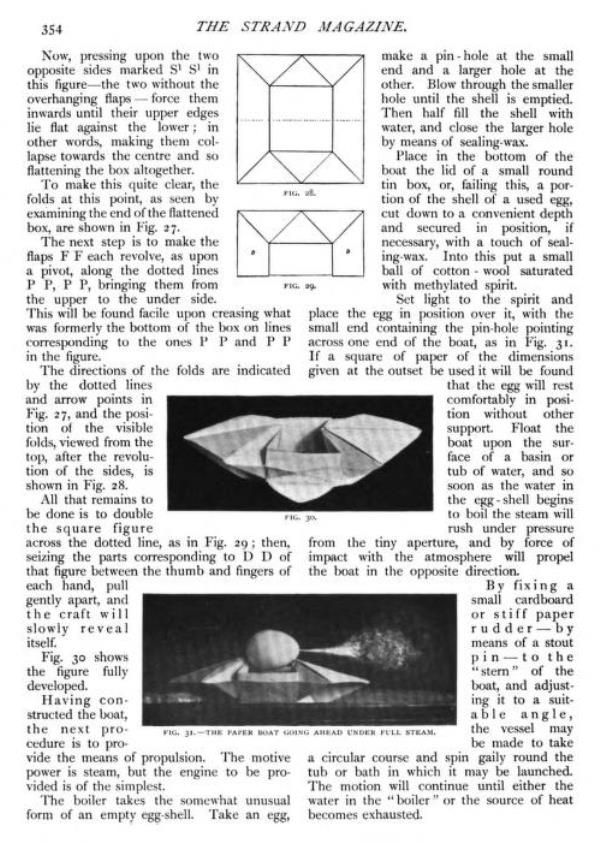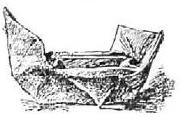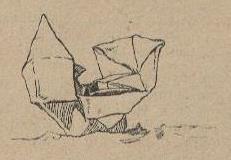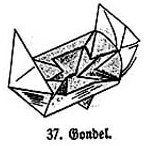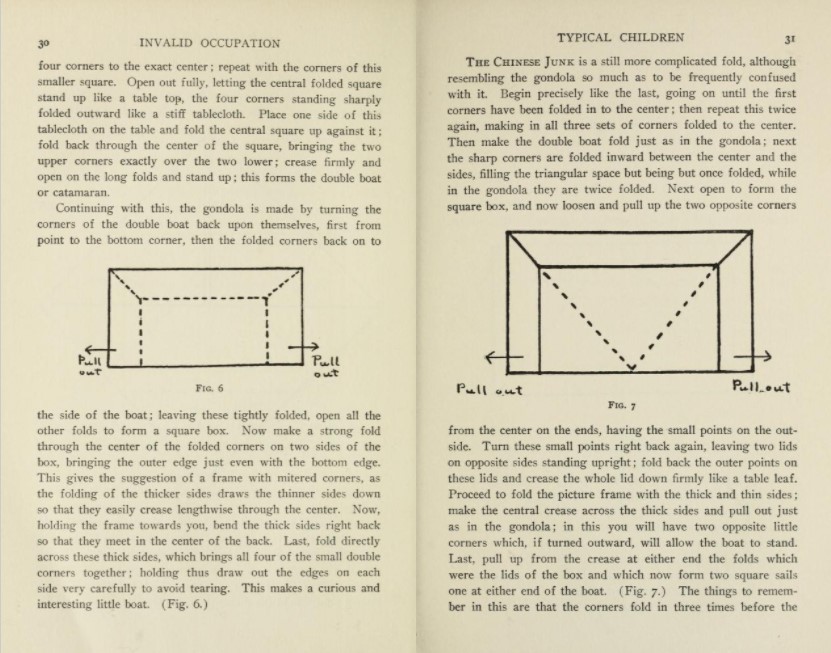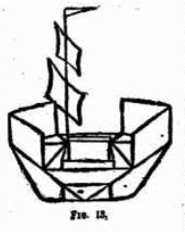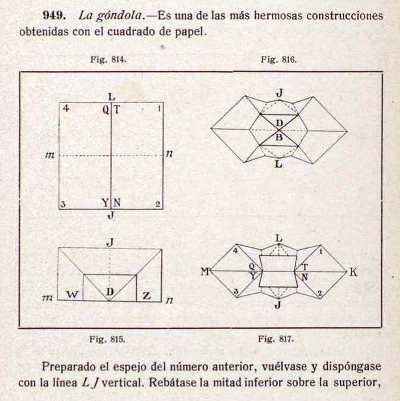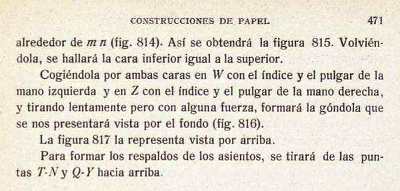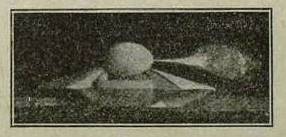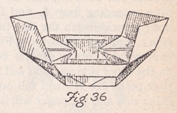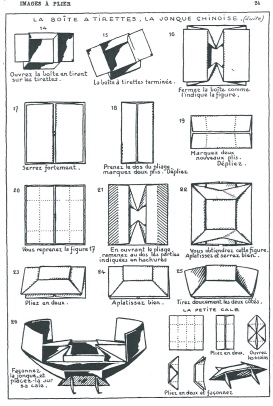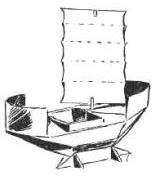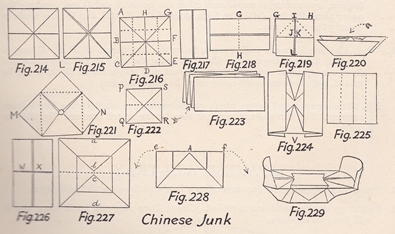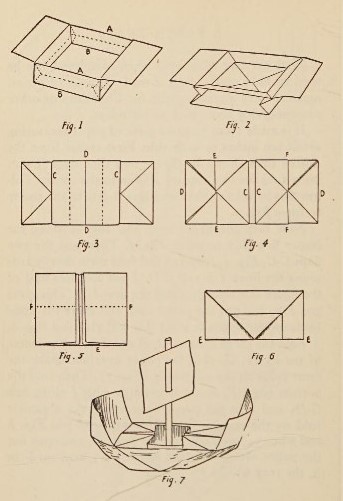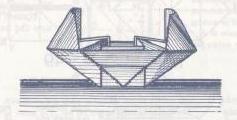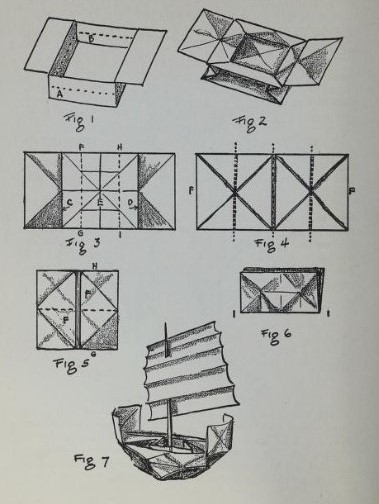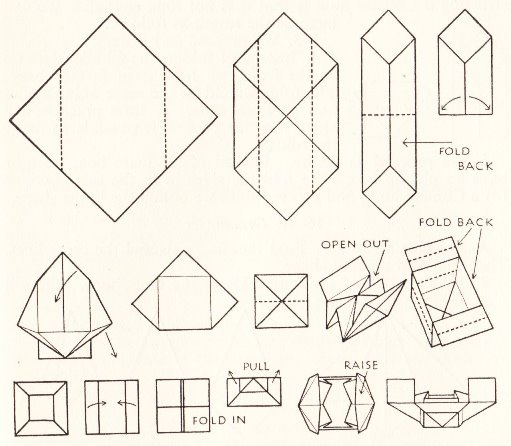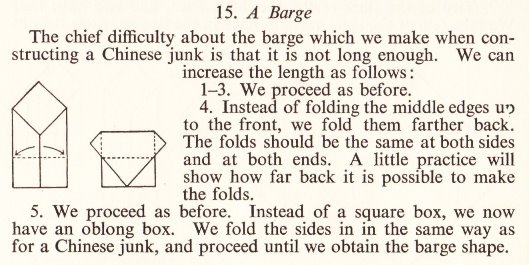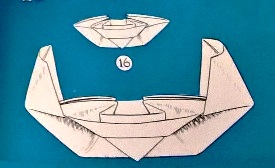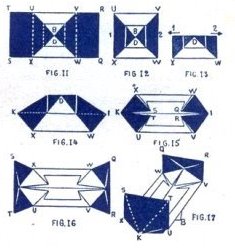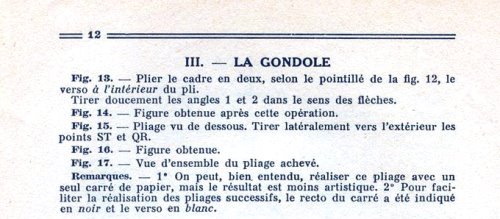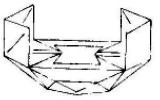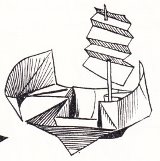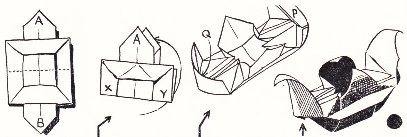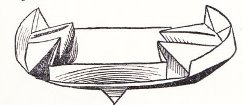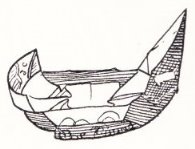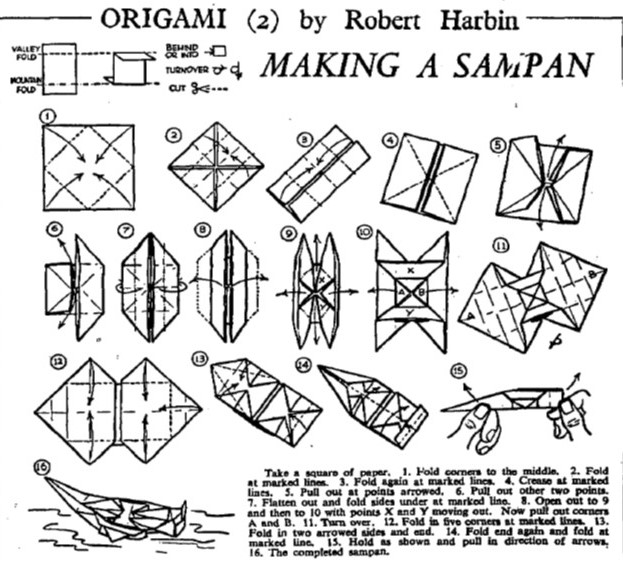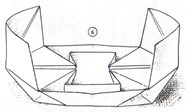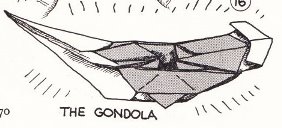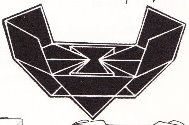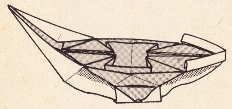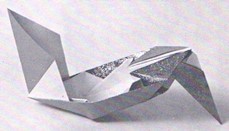| The Public Paperfolding History Project
Last updated 9/10/2025 x |
|||||||
| The Gondola / The Chinese Junk / The Takarabune | |||||||
| This
page is being used to collect information about the
history of the paperfolding designs known in the West as
the Chinese Junk and the Gondola, and in Japan under
various names such as Takarabune (Treasure Ship) /
Sengokubune / Yamatobune / Chousenbune. Please contact me
if you know any of this information is incorrect or if
you have any other information that should be added.
Thank you. I use the name 'Chinese Junk' for the standard European version which is developed from a blintzed windmill base, and which usually has two seats, one at each end, or less usually a seat at one end and a prow at the other, or for the versions with similar appearances developed in other ways. I use the name 'Gondola' to mean the simpler variant of the Chinese Junk that is developed from a standard windmill base, and which therefore lacks seats / sails. I use the name 'Takarabune' for any Japanese version of the design which either clearly predates, or is different from, the Western version. That difference may be either in appearance or folding sequence. While the Chinese Junk is usually developed from the Junk Box, the Takarabune is usually developed from the Tenjin Shrine. ********** The Chinese Junk design appears in various versions in different places with either blunt or pointed ends. In his article 'Is the Junk Chinese?', now available as part of the Lister List on the British Origami Society website, David Lister states that in Japan the Chinese Junk design is known as the tenmsen (cargo boat) or treasure ship (takara-bune) and has pointed ends (whereas most of the European versions of the design have blunt ends). It also occurs with one blunt and one pointed end. The significance of these differences is not completely clear although Koshiro Hatori, writing in an article entitled 'History of Origami in the East and West before Interfusion', which can be found in the proceedings of 'Origami 5: Fifth International Meeting of Origami Science, Mathematics and Education' says, 'This difference is, in my opinion, so critical that I am sure the Chinese Junk and takara-bune developed independently on opposite sides of the world.' In this connection, in the interests of avoiding confusion, it is worth noting that, according to Robin D Gill, writing in his book 'Octopussy: Dry Kidney and Blue Spots' published by Paraverse Press in 2007, which is a treatise on Senryu poetry, the word takarabune can also be used as a euphemism for female genitalia. ********* A distinctive characteristic of the design is the final 'pull-out' move that turns a flat paperfold into a three-dimensional boat. On the basis of this move, but of no other evidence, in his book 'Complete Origami', Eric Kenneway makes a connection between the Chinese Junk and Chinese funerary paperfolds (otherwise known as Yuan Bao) and concludes that 'its similarity to a Chinese ceremonial fold places it firmly in the Chinese tradition.' I no longer agree with this position. ********** In China (and in publications by Chinese authors) 1914 Diagrams for a 'Dragon Boat' appear in 'Zhe zhi tu shuo' (Illustrated Paperfolding), compiled by Gui Shaolie, which was published by the Commercial Press in Shanghai in Ming guo 3 (1914).
********** 1934 The design also appears as 'Sand Boat' in 'Zhezhi Xinfa' (New Ways to Fold Paper), which was published by The Commercial Press in China in 1934.
********** In Japan (and in publications by Japanese authors) 1704 This pattern for a kosode featuring several Takarabune is from 'Tanzen Hiniigata', which was published in 1704. Source: 'Origami koten ni miru origami' Origami in the Classics) by Satoshi Takagi, which was published by the the Yasuhiro Sano, publishing office, Nippon Origami Association, in 1993.
********** 1830-42 This print by Kunisada Utigawa from 'Nisemurasaki Inaka Genji' showing a takarabune is said to date from between 1830 and 1842. Source: 'Origami from the Classics' by Satoshi Takagi, published in 1993. The blog post Daruma Pilgrims in Japan: Suma and Iro no Hama contains the following information explaining the meaning of this print, which is probably a quotation from the text of 'Nisemurasaki Inaka Genji', although this is not explicitly stated: 'Prince Genji came to exile in Suma and performed a purification ritual upon his arrival there ... Genji had part of the beach separated by a curtain, and called a calendar shaman (onmyooshi ???) to perform the rituals. The shaman put a folded paper doll on a small paper boat and floated it to take away the bad fortune of the prince.'
********** 1885 A picture of a Takarabune design, under the title 'chousen fune' (which translates as 'korean boat'), appeared in 'Kindergarten Shoho' (Preliminary Kindergarten) by Iijima Hanjuro, which was copyrighted on October 4th Meiji 17 (1884) and published by Fukuda Senzo in August of Meiji 18 (1885).
********** 1892 The Takarabune also appears, under the title 'chousenbune' (which translates as 'korean boat'),in 'Kani Shukogaku' (Simple Handicraft) by Tamotsu Shibue, which was published in Tokyo in 1892. It is worth noting that in this version of the design neither end is pointed.
********** 1893 An unusual version of the design, developed from the Cross, appears under the name 'Yamatobune' in 1893 in volume 3 issue 23 of 'Yonen Zasshi' children's magazine.
********** 1894 The Takarabune design is mentioned, but not illustrated, under the alternative name 'Sengokubune' in issue 1984 / 12 of the Japanese children's magazine 'Shokokumin'. Sengoku means a large amount of grain, hence wealth or treasure.
********** 1903 Diagrams for the Takarabune (made via the Tenjin Shrine) appear in 'Jinjo Kouto Shogaku Shuko Seisakuzu' (Handicrafts for ordinary higher elementary schools) by Hideyoshi Okayama, which was published by Rokushiro Uehara in Tokyo in 1903.
********** 1905 Diagrams, also made via the Tenjin Shrine, also appear in 'Shukouka Kyohon : Liron Jishuu Souga Setsumei' by Kikujiro Kiuchi, Rokushiro Uehara and Hideyoshi Okayama, which was published by Shigebei Takase in Chiba in 1905. I cannot translate the Japanese title.
********** 1907 Diagrams appear in 'Shukou Tebikigusa : Kokumin Kyoiku Origami Yuihimo' by Ishin Nishigaki, which was published by Meguro Shoten in Nagaoka in 1907.
********** 1908 Diagrams that show how to convert the Tenjin Shrine into the Takarabune (called Korean Boat here) appear in 'Origami zusetsu' (Illustrated Origami) by Sano Shozo, which was published in Tokyo in 1908.
********** 1912 A drawing of a version of the Chinese Junk appears in a monozukushi-e print, by an unknown artist, but said to be from the Meiji era. I have temporarily assigned it the date of 1912, the last year of that era, pending the discovery of more accurate information.
********** 1935 'Origami Moyo, Book One', by Kawarazaki Kodo, which was published by Unsodo in Japan in 1935, contains a print showing a version of the Chinese Junk.
********** 1944 The design appears as 'Chousenbune' or 'Sengokobune' in 'Origami Shuko' by Isao Honda, which was published in 1944.
********** 1960 A design for a 'A Korean Junk' appears in 'All About Origami' by Isao Honda, which was published by Toto Bunka Company, Limited in Tokyo in 1960. This design is unusual because it has one pointed and one blunt end.
********** 1965 The design appears as 'Ship C' in 'Origami in the Classroom: Book 1: Activities for autumn through Christmas' by Chiyo Araki, which was published by Charles E Tuttle Co Inc in 1965.
********** In Europe, the Americas and Australasia c1807 The earliest known appearance of the design in Europe is a drawing in the picture book 'Hanenpoot' which the Dutch poet Willem Bilderdijk is said to have drawn / written for his son Julius Willem in around 1807 (although the ms was kept private within the family and not published publicly until 1977). I do not know what the evidence for the 1807 date is.
Unlike almost all other Western drawings of this design, the boat in this drawing has a flat, pointed prow, and so closely resembles the Japanese version of the design. This raises the possibility that the Japanese version of the design had somehow reached the Netherlands and become known to Willem Bilderdijk, though how this could have happened is not clear. The words below the picture read 'Hanenpoot sails stout and proud, In a ship of paper'. ********** 1848 It is perhaps worth noting that a real chinese junk, the Keying, had sailed from Hong Kong in December 1846 and arrived in London, via New York, Boston and Jersey in March 1848, where she proved to be a considerable tourist attraction, so that many people in Europe and America would have known what a real chinese junk was, and looked like, at this time. ********** 1859 The book 'Manual Pratique des Jardins d'Enfants' edited by J-F Jacobs, which was written in French and published in Brussels and Paris in 1859 contains two lists of designs, but no illustrations of them, making identification of some designs in the list problematical. Among the designs listed are: From list 1: 22. La gondole. Based on the evidence of its position in the sequence of designs, this can be identified as the Gondola developed from the windmill base. As far as I know this is the first appearance of the Gondola design in the historical record. 23. La gondole avec des bancs (the gondola with benches). If I am right about the designs in the sequence leading up to this point then this item in the list appears to be an error ... since there are no flaps to pull out to change the form to add benches to the design. From list 2: 19. La gondole simple ie the Chinese Junk without the sails raised. 20. La gondole avec roues. This is presumably a variation of the Chinese Junk, although at present it cannot be identified. 21. La gondole à voiles. The Chinese Junk itself. 22. La gondole fermée. This is presumably another variation of the Chinese Junk, although at present it also cannot be identified. ********** 1863 The Chinese Junk appears as 'De sloep of gondel, het wiegje' (The sloop or gondola, the crib) in 'De Kleine Papierwerkers 1: Wat men van een stukje papier al maken kan: Het vouwen' (The Small Paperwork 1: What one can make from a piece of paper: Folding) by Elise Van Calcar, which was published by K H Schadd in Amsterdam in 1863.
********** 1866 There is reference to a paper boat (galiote) in 'La Peau de Tigre' by Theophile Gautier, published by Michel Levy Freres in Paris in 1866. (Information from Juan Gimeno.) In the original French: 'Je compris alors l’énormité de ma faute ; je tombai à genoux et je baisai la poussière des bottes magistrales ; je répandis un sac de cendre sur ma tête, et par la sincérité de mon repentir, ayant obtenu le pardon du grand homme, j’envoyai au Salon une peinture à l’eau d’œeuf représentant une Madone lilas tendre et un Enfant Jésus faisant une galiote en papier.' In English: 'I then understood the enormity of my fault; I fell on my knees and kissed the dust of the majestic boots; I spread a sack of ash on my head, and by the sincerity of my repentance, having obtained the forgiveness of the great man, I sent to the Salon a painting in egg tempera representing a tender lilac Madonna and a baby Jesus making a paper boat.' In view of the use of the word 'galiote' to refer to the Chinese Junk by Victor Hugo (see below) it seems probable, though not completely certain, that this mention of a paper boat is a reference to the Chinese Junk design. ********** 1869 Victor Hugo's story 'L'Homme que rit' ('The Man Who Laughs'), published in 1869, contains the words: 'Le bâtiment amarré au bout de l'estacade était une de ces panses de Hollande à double tillac rasé, l'un à l'avant, l'autre l'arrière, ayant, à la mode japonaise, entre les deux tillacs, un compartiment profond à ciel ouvert où l'on descendait par une échelle droite et qu'on emplissait de tous les colis de la cargaison. Cela faisait deux gaillards, l'un à la proue, l'autre à la poupe, comme à nos vieilles pataches de rivière, avec un creux au milieu. Le chargement lestait ce creux. Les galiotes de papier que font les enfants ont à peu près cette forme.' which translate to English as: 'The ship moored to the wharf was a Dutch vessel, of the Japanese build, with two decks, fore and aft, and between them an open hold, reached by an upright ladder, in which the cargo was laden. There was thus a forecastle and an afterdeck, as in our old river boats, and a space between them ballasted by the freight. The paper boats made by children are of a somewhat similar shape.' which is a clear reference to the Chinese Junk design. ********** A design called 'Ein Boot', which is not illustrated, but which from the context is most probably the Gondola, appears in a list of designs in 'Der Kindergarten' by Hermann Goldammer, which was published by Habel in Berlin in 1869. The same book gives a second list of designs which includes a design called 'Die Gondel', which from the context is most probably the Chinese Junk. ********** 'Paradise of Childhood' by Edward Wiebe, which was published by Milton, Bradley and Company in Springfield, Massachusetts in 1869, and is effectively a translation of Goldammer's 'Der Kindergarten', similarly includes a designs called the 'gondola' and the 'boat with seats', which are probably the Chinese Junk and the Gondola respectively, in its list of Forms of Life. ********** 1873 The Chinese Junk also appears, under the name 'Gondel' in 'Die Praxis Des Kindergartens' by August Koehler, which was published by Herman Bohlau in Weimar in 1873. There are written folding instructions for developing the design from the Junk Box but no diagrams.
********** As far as I know diagrams for making the Chinese Junk first appear, as the 'Paper Chinese Junk' in 'The Popular Recreator', which was published by Cassell and Co in London in 1873. The author of the article, whose name is not given in the book and is not known to us, states 'This used to be a favourite paper toy with us at school, but I never saw an account of it in any book that I can call to mind.'
********** In 'Exercices et Travaux pour les Enfants Selon la Méthode et les Procédés de Pestalozzi et de Froebel' by Fanny and Charles Delon, which was published by Librairie Hachette in Paris in 1873, there is a list of designs which includes 'La barque a voiles' (the boat with sails) and 'La gondole' (the gondola). These are quite possibly references to the Chinese Junk and the Gondola but there are no illustrations to confirm the identifications. ********** 1874 The Chinese Junk appears in an illustration, but is not otherwise mentioned, in 'Spiel und Arbeit' by Hugo Elm, which was published by Verlag und Drud der Otto Spamer in Leipzig in 1874.
********** 1875 As 'De gondel' in 'Froebels Methode' by Elise Van Calcar, which was published in 1875. ********** 1876 The Chinese Junk also appears in 'Des Kindes Erste Beschaftigungsbuch' by E Barth and W Niederley, which was first published in Bielefeld and Leipzig, and the foreword of which is dated October 1876.
********** 1880 Both the Gondola and the Chinese Junk appear in 'The Kindergarten Principle' by Mary J Lyschinska, which was published in London in 1880 by Wm Isbister Ltd. The Gondola is called 'The Boat' and the Chinese Junk just 'Boat'.
********* Diagrams for the Chinese Junk, under the title 'La Jongue Chinoise', appear in 'Un million de jeux et de plaisirs' by T de Moulidars, which was first published in 1880 and subsequently republished under the title 'Grande encyclopédie méthodique, universelle, illustrée, des jeux et des divertissements de l'esprit et du corps' in 1888.This is the first occasion I know of where the equivalent of the name 'Chinese Junk' is used. ********** 1881 The same set of diagrams appears again in 'Cassell's Book of Indoor Amusements, Card Games and Fireside Fun', which was published by Cassell and Co in London in 1881.
********** 1882 The Gondola appears, under the name of 'The Chinese Junk' in part two of 'The Kindergarten Guide' by Maria Kraus Boelte and John Kraus, which was probably first published by E. Steiger and Company in New York in 1882.
The design that we now call the Chinese Junk also appears in the same book under the title of 'The Gondola'.
********** 1883 'Giuochi Fanciulleschi Siciliani' by Giuseppe Pitri, which was published by Luigi Pedone Lauriel in Palermo in 1883, contains a drawing of the Chinese Junk under the name 'La Varca, la barca'.
********** A similar drawing of the Chinese Junk appears in a pictorial story by Apeles Mestres dated 2nd August 1883 found in his Llibre Vert III.
********** 1884 The Chinese Junk (La galiote dont les banquettes ont des rebords) is illustrated in 'Jeux et Jouets du Jeune Age' by Gaston Tissandier, which was published by G Masson in Paris in 1884, but no folding instructions are given.
********** 1886 'The Boy's Own Paper' no 389 of 26th June 1886 contained an article entitled 'A Paper Bird and a Paper Boat' which gave instructions for folding the Chinese Junk (not named but referred to as 'a very fair representation of a barge' and 'one of the best of the paper boats'.
********** 1887 As 'Bateau, gondole ou galiote' in 'Le Travail Manuel a L'ecole Primaire' by M. Coste et J. Lapassade, which was published by Lafon, Vve Ribaut et Tonnet in Pau and A Jeande in Paris in 1887.
********** In the September 1887 issue of the American children's magazine St Nicholas under the title of 'The First Paper Canoe'. The writer, identified only as H. E., states that he learned the design in England as a child.
In the December issue of the same year this reader's letter appeared in the Letterbox column:
********** As 'Paper Chinese Junk' in 'The Home Book for Very Little People' by J H Vincent, which was published by Phillips and Hunt in New York in 1887.
********** 1888 In 'Wide Awake: Volume Z', which was published by D Lothrop Company in Boston in 1888.
********** 1889 On his website 'Bits of Smith', John Smith notes that in the The Magic of Lewis Carroll, Nelson, 1973, the editor John Fisher, quotes a passage from Lewis Carroll's diaries which reads. "We were playing on the fort at Margate, and a gentleman on a seat near asked us if we could make a paper boat, with a seat at each end and a basket in the middle for fish." This sounds like a description of either the Chinese Junk or the Gondola. No date for this incident is given, however this clearly raises the possibility that the folded paper fishing boats referred to on several other occasions in Lewis Carroll's diaries might have been either Chinese Junks or Gondolas rather than, as I have always previously assumed, the much simpler paper boat design made from the newspaper hat. One of the earliest of these references is from June 1889 and reads, 'Once at luncheon I had the Duchess (of Albany) as neighbour and once at breakfast, and had several other chats with her, and found her very pleasant indeed. Princess Alice is a sweet little girl. Her little brother (the Duke of Albany) was entirely fascinating, a perfect little prince, and the picture of good-humour. On Sunday afternoon I had a pleasant half-hour with the children, telling them "Bruno's Picnic" and folding a fishing-boat for them.' ********** 'La Nature' of 28th September 1889 contained an article headed 'Recreation Scientifiques' and subheaded 'La Grenouille Japonaise en Papier' (The Japanese Paper Frog) which includes the words (here in translation) 'In France, it is true, we also know the charming game of folding paper. The classic Cocotte, the box and the galiote etc., are popular here but we must agree that the Japanese have more ingenious models.' The galiote mentioned here is most probably the Chinese Junk. ********** Diagrams for the Chinese Junk also appear: 1890 As 'Une chaloupe' (boat) appear in 'Les travaux manuels a l'ecole primaire a l'usage des ecoles de garcons' by Dauzat and Deramond, which was published by Alcide, Picard et Kaan in Paris in 1890.
********** As 'Gondole' in 'Le travail manuel a l'ecole et dans la famille' by MM, Bertrand, Toussaint and Gombert, which was published by Loucene, Oudin et ces Editeurs in Paris in 1890.
********** 1891 In 'The Boy's Own Paper' issue 655 of 1st August 1891, as the 'Chinese Junk'.
********** 1893 In 'L'Annee Preparatoire de Travail Manuel' by M P Martin, which was published by Armand Collin & Cie in Paris in 1893.
********** As 'El barco' in 'Cuestiones de Pedagogía Práctica: Medios de Instruir' by D Vicente Castro Legua, which was published by Libreria de la Viuda de la Hernando y Ca in Madrid in 1893.
********** 1896 As 'El junco chino' in 'Repertorio Completo de Todos los Juegos' by de Luis Marco y Eugenio de Ochoa y Ronna, which was published in Madrid by Bailly-Bailliere e hijos in 1896.
********** 1900 In 'Mes Jolie Jeux' by Henriette Suzanne Bres was published by Librairie Hachette in Paris in 1900.
********** 1904 In 'Guia Practica del Trabajo Manual Educativo' by Ezequiel Solana, which was published by Editorial Magisterio Español in Madrid in 1904, under the title of 'Gondola'.
********** 1905 An article titled 'A Boiling Kettle and a Working Steamboat Made of Paper' by Louis Nikola was published in 'The Strand Magazine' in March 1905 in which the Chonese Junk is turned into a working steamboat by using an egg as a boiler.
********** 1907 As 'Barco griego' (Greek ship) in an article titled 'El trabajo manual escolar' by Vicente Casto Legua in the January 1907 issue of the Spanish magazine 'La Escuela Moderna' which was published in Madrid by Los Sucesores de Hernando.
********** 1908 In the last ever issue of the Catalan satirical magazine 'La Campana Catalana', published in Barcelona on 29th April 1908, in a cartoon by Apeles Mestres which pictures a variety of paperfolding designs. This pictorial story had previously been published in his Llibre Vert III in 1883.
********** 1910 As 'Gondel' (gondola) in Part 2 'Das Flechten' of 'Die Frobelschen Beschaftigungen' by Marie Muller-Wunderlich, which was published by Friedrich Brandstetter in Leipzig in 1910.
********** The Gondola appears as 'Gondel' in 'Allerlei Papierarbeiten' by Hildergard Gierke and Alice Kuczynski, which was published by Drud und Verlag B G Teubner in Leipzig and Berlin in 1910.
*** The Chinese Junk appears in the same book as 'Gondel mit Lehnen' (Gondola with Backrests).
********** Folding methods for both the Gondola and the Chinese Junk are described in 'Studies in Invalid Occupation' by Susan E Tracy, which was published by Whitcomb and Barrows in Boston in 1910.
********** As 'The Chinese Junk' in 'Handicraft in the School', which was issued in four volumes by Gresham Publishing in London in 1910.
********** 1912 In an article by Morley Roberts in The Week, 6th December 1912, which was published in Queensland, Australia.
********** 1918 As 'La Gondola' in 'Ciencia Recreativa' by Jose Estralella, which was published by Gustavo Gili in Barcelona in 1918.
********** 'Los Muchachos' magazine of 23rd June 1918 contained an article showing how to turn a 'barquito de papel' into a steam-powered vessel using an egg (translated from The Strand Magazine - see entry for 1905 above).
********** 1920 In 'Paper Magic' by Will Blyth, which was first published by C Arthur Pearson in London in 1920.
********** c1929 As 'Gondola' in booklet 2 of 'Trabajos Manuales Salvatella - Plegado de figuras de papel', which was published by Editorial Miguel A Salvatera in Barcelona, pobably in or around 1929.
********** 1928 In 'Fun with Paperfolding' by William D Murray and Francis J Rigney, which was published by the Fleming H Revell Company, New York in 1928.
********** 1931 As 'Gondel' in the revised 3rd edition of 'Lustiges Papierfaltbüchlein' by Johanna Huber, which was published by Otto Maier in Ravensburg, Germany in 1931.
********** 1932 In 'Winter Nights Entertainments' by R M Abraham, which was first published by Constable and Constable in London in 1932.
********** In booklet 2 of 'Images a Plier', a series of 6 booklets published by Librairie Larousse in Paris in 1932. This booklet also includes a design for a Petite Cale (Little Stand) to support the base of the design.
********** In booklet 2 of 'Figuras de Papel', a series of 3 booklets published by B Bauza in Barcelona in 1932. The design is equipped with a stand to support the base of the design and, in this case, also with a sail.
********** 1936 In 'Paper Toy Making' by Margaret Campbell, which was first published by Sir Isaac Pitman and Sons Ltd in London, probably in 1937, although both the Foreword and Preface are dated 1936, which argues that the book was complete at that date.
********** As 'A Paper Chinese Junk' in 'More Things Any Boy Can Make' by Joseph Leeming, which was published by D Appleton-Century Company in New York and London in 1936.
********** 1939 In 'El Mundo de Papel' by Dr Nemesio Montero, which was published by G Miranda in Edicions Infancia in Valladolid in 1939, as 'El barco de la reina' (The Queen's ship).
********** 1939 As 'A Chinese Junk' in 'Fun with Paper' by Joseph Leeming, which was published by Spencer Press Inc in Chicago in 1939.
********** In 'At Home Tonight' by Herbert McKay, which was published by Oxford University Press in London, New York and Toronto in 1940, contains diagrams for the Chinese Junk and a longer variation, called 'A Barge'.
*** A Barge (a longer variation also folded from a square)
********** 1949 The design featured in the 1949 Rupert Annual under the heading 'How To Make Rupert's Boat'.
********** 1951 As 'Gondole' in 'Occupons nos doigts' by Raymond Richard which was published by Les Editions du Cep Beaujolais in Villefranche-sur-Rhone in 1951.
********** 1952 As 'Barca del Rey y la Reina' in 'Una Hoja de Papel' by Lorenzo Herrero, which was published by Miguel A Salvatella in Barcelona in 1952.
********** 1956 Robert Harbin's 'Paper Magic', first published by Oldbourne in London in 1956, contains diagrams for various versions of the design and the information that similar designs can be folded from 'practically any paper box without a lid' and from oblongs as well as from squares'. The Barge (The Chinese Junk wihout the ends raised) The text says, 'Origin:Japanese'.
*** The Chinese Junk
*** Harbin's version with superstructure (developed from the Buckle)
*** Cleopatra's Barge (developed from the Bar and Bolt) Attributed to Gershon Legman
*** Long Chinese Junk (untitled in the book) Herbert McKay's method of making a longer Chinese Junk from a square.
The author extends this idea to make longer versions still from lomger strips of paper. *** Harbin's Pound Note Barge (a version folded from a pound note)
********** The Chinese Junk / Takarabune also appears: 1960 As 'Sampan' in an article by Robert Harbin in The Observer, 3rd January 1960. NB This is the Takarabune not the Chinese Junk.
********** 1961 As 'Italienische Gondel' in 'Wir Falten' by Joachim Schönherr and Gerta Schumann, which was published by Rudolf Arnold Verlag in Leipzig in 1961. ********** 1963 As the 'Gondola' in the second edition of 'Het Grote Vouwboek' by Aart van Breda, which was published by Uitgeverij van Breda in 1963.
********** As 'The Gondola' in 'Party Lines' by Robert Harbin, which was published by the Olbourne Book Co in London in 1963.
********** A stretched version of the design folded from a dollar bill appears as 'Barge' in 'The Folding Money Book', which was published by The Ireland Magic Co in Chicago in 1963.
********** 1964 As the culmination of the Multiform sequence, in 'Secrets of Origami', by Robert Harbin, which was published by Oldbourne Book Company in London in 1964.
********** 1968 A version of the Chinese Junk with one pointed end, called the 'Gondola', appears in 'Teach Yourself Origami: The Art of Paperfolding' by Robert Harbin, which was published by The English Universities Press in 1968 as the final design in a Multiform sequence, although it is not developed via the Junk Box.
********** 1969 A heavily modified version of the design appears in 'Modern Origami' by James Minoru Sakoda, which was published by Simon and Schuster in New York in 1969.
********** |
|||||||
